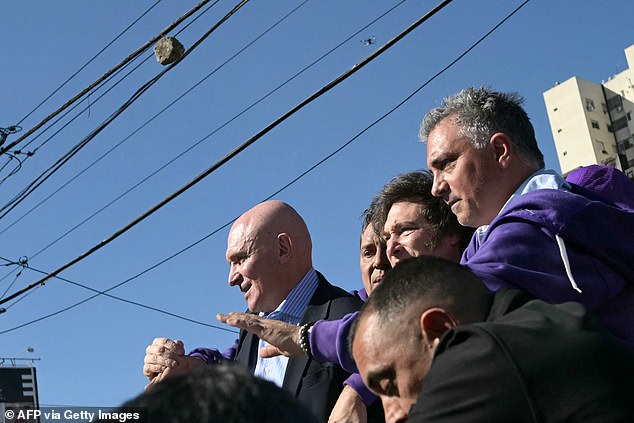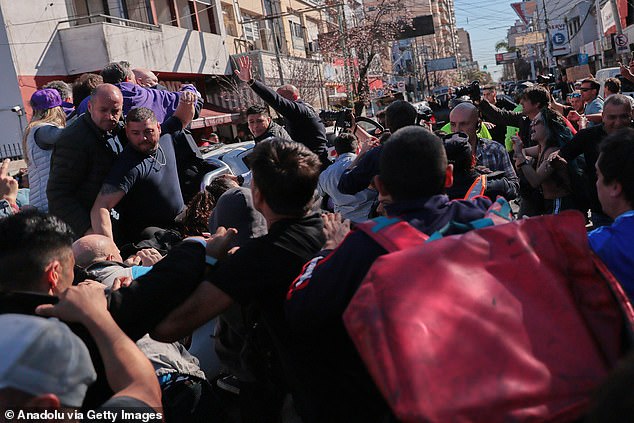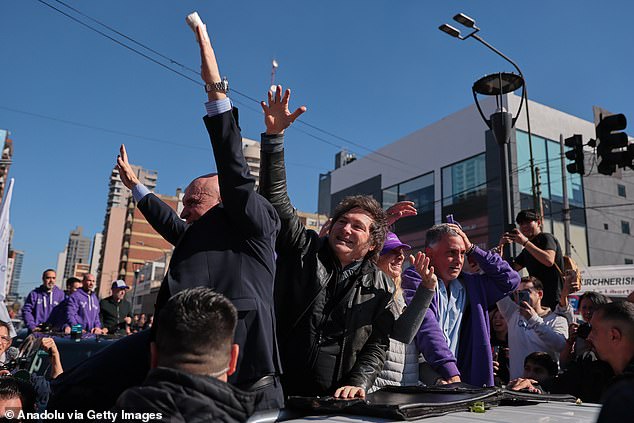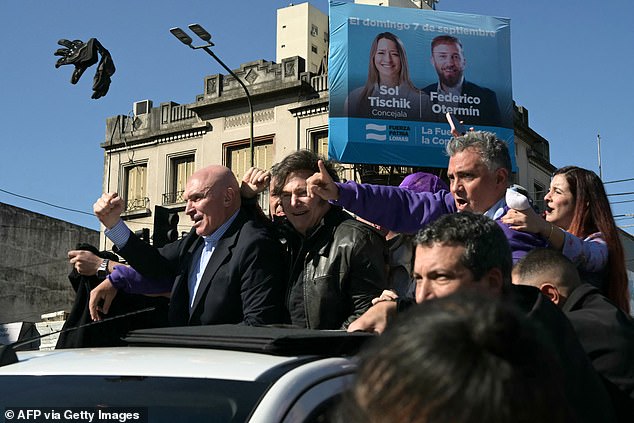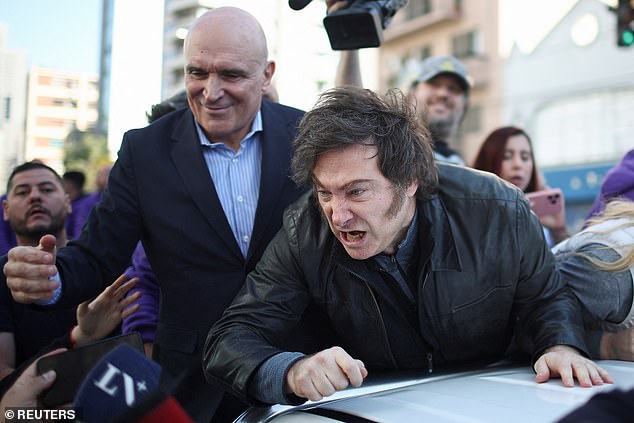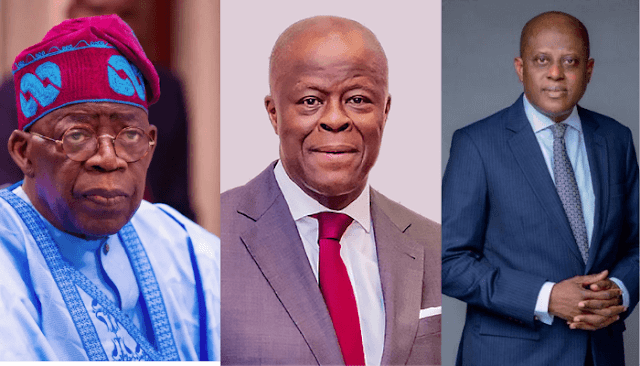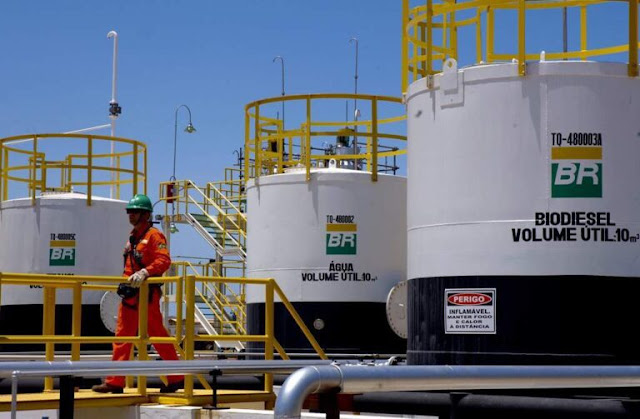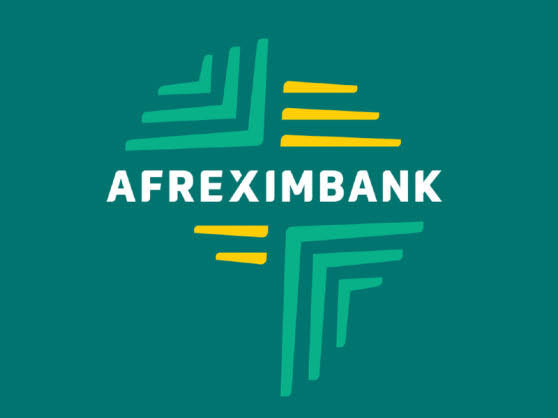On Wednesday, August 27, 2025, Argentine President Javier Milei faced a violent outburst during a campaign event in Lomas de Zamora, a city located approximately 20 kilometers south of Buenos Aires. While riding in the back of a pickup truck to greet supporters as part of his campaign for the October 2025 mid-term elections, Milei was targeted by protesters who pelted his motorcade and personal vehicle with plants, rocks, and bottles. The incident, which forced his security detail to swiftly evacuate him from the scene, was fueled by public anger over an alleged corruption scandal involving the president’s sister, Karina Milei, and the National Disability Agency. This article provides a detailed examination of the incident, its political context, the corruption allegations, and the broader implications for Argentina’s polarized political landscape as the nation approaches a critical electoral moment.
The Incident: A Violent Disruption in Lomas de Zamora
The chaotic scene unfolded in Lomas de Zamora, a working-class suburb of Buenos Aires, as President Milei campaigned for the upcoming mid-term elections scheduled for October 26, 2025. Riding in an open pickup truck alongside his sister, Karina Milei, and other officials, the president was engaging with supporters, waving and signing autographs, when the atmosphere turned hostile. According to eyewitness accounts and livestreamed footage reported by outlets such as AFP and Al Jazeera, demonstrators began hurling objects—including plants, rocks, and bottles—at the motorcade. The attack was sudden and intense, disrupting what was intended to be a routine campaign stop.
The projectiles targeted not only the president’s vehicle but also those in his entourage, creating a dangerous situation. A photographer was knocked over during the melee, and scuffles broke out between Milei’s supporters and the protesters, resulting in injuries. Notably, a female supporter of the president suffered rib injuries and required medical attention, highlighting the physical toll of the confrontation. Presidential spokesperson Manuel Adorni took to X to condemn the protesters, sharing an image of a stone thrown toward Milei and stating, “They could have killed anyone. They don’t care about human life, and they’ll care even less about the country. The end.” The swift intervention of Milei’s security detail ensured that he and his sister escaped unharmed, but the incident cast a shadow over his campaign efforts.
The violence in Lomas de Zamora was not an isolated act but a manifestation of mounting public frustration, particularly linked to a corruption scandal that has rocked Milei’s administration. The demonstrators, some of whom chanted “Out with Milei!” and held up mock suitcases adorned with Karina Milei’s image and fake dollar bills, were protesting allegations of graft at the National Disability Agency, where Karina holds a high-ranking position as the president’s general secretary. The incident underscores the volatile political climate in Argentina as the mid-term elections approach, with Milei’s libertarian agenda facing significant opposition.
The Corruption Scandal: Allegations Against Karina Milei
At the heart of the protests lies a bribery scandal implicating Karina Milei, the president’s sister and one of his closest advisors. The controversy stems from leaked audio recordings by Diego Spagnuolo, the former head of the National Disability Agency and a close ally of Milei. In these recordings, which have dominated Argentine media for days, Spagnuolo alleged that Karina Milei pocketed funds intended for people with disabilities, siphoning off a percentage of government contracts for personal gain. The accusations also implicate other figures, including Eduardo “Lule” Menem and Congress Speaker Martín Menem, in a scheme involving inflated prices for medications and health services provided by Suizo Argentina, a company linked to the Menem family.
The scandal has been particularly damaging for Milei, who campaigned in 2023 on an anti-corruption platform, promising to dismantle Argentina’s entrenched political “caste.” The allegations against his sister, who holds a powerful position in his administration, undermine his narrative of integrity and reform. In response, Milei has vehemently denied the claims, calling Spagnuolo’s statements “a lie” during a press interaction in Lomas de Zamora just minutes before the attack. “We are going to bring him to justice and prove he lied,” Milei declared, announcing that Spagnuolo had been fired from his position. Despite these denials, the scandal has fueled public outrage, particularly among those who feel that Milei’s austerity measures have disproportionately harmed vulnerable populations, including people with disabilities.
The protests in Lomas de Zamora were marked by symbolic gestures, such as the mock suitcase with Karina’s image, which served as a visual critique of the alleged corruption. The public’s anger reflects broader discontent with Milei’s administration, which has implemented sweeping economic reforms, including cuts to social services, government layoffs, and deregulation. While these policies have reduced inflation, they have also increased unemployment and poverty, exacerbating tensions and providing fertile ground for opposition attacks.
Political Context: Milei’s Leadership and the Mid-Term Elections
Javier Milei, a libertarian economist, rose to prominence with his 2023 election victory, which disrupted Argentina’s traditional political establishment dominated by the Peronist and Radical parties. Campaigning with a chainsaw to symbolize his intent to slash government bureaucracy, Milei promised to revive Argentina’s ailing economy through free-market policies, fiscal discipline, and anti-corruption measures. His administration has achieved some successes, such as reducing stubbornly high inflation and producing a budget surplus, but these gains have come at a significant social cost. Critics argue that his austerity measures, including cuts to disability services, have left Argentina’s poorest citizens more vulnerable, fueling resentment.
The October 2025 mid-term elections are a critical test for Milei’s La Libertad Avanza party, as they will determine the composition of half of the 257-seat Chamber of Deputies and a third of the Senate. These elections, alongside local elections in Buenos Aires province on September 7, 2025, will gauge public support for Milei’s reforms at the midpoint of his four-year term. The violence in Lomas de Zamora highlights the challenges he faces in maintaining his political momentum amid growing opposition and public unrest.
The corruption scandal has amplified these challenges, striking at the heart of Milei’s anti-establishment rhetoric. The allegations against Karina Milei, combined with the involvement of the Menem family—long associated with Argentina’s political elite—undermine his claim to represent a break from the corrupt practices of the past. The opposition, particularly the left-wing Kirchnerist movement, has seized on the scandal to portray Milei as hypocritical, accusing him of protecting his inner circle while cutting services for the vulnerable. Milei’s response, framing the protesters as “empty-headed nutters” and rallying against “Kirchnerism” on social media, reflects his strategy to deflect criticism and mobilize his base by painting the opposition as violent and obstructionist.
The Response: Milei’s Defiance and Political Strategy
In the wake of the attack, Milei and his administration have adopted a defiant stance. The president used the incident to reinforce his narrative of being under siege by a corrupt and violent opposition. In posts on X, he wrote, “The empty-headed nutters throwing rocks resorted to violence again. On September 7 and October 26, let’s say at the polls: KIRCHNERISM NEVER AGAIN.” In another post, he framed the upcoming elections as a choice between “civilisation or barbarity,” positioning himself as a defender of order against chaos.
This rhetoric is consistent with Milei’s broader political strategy, which relies on polarizing language to galvanize his supporters. By blaming the Kirchnerist movement—a left-wing political force associated with former presidents Néstor and Cristina Kirchner—Milei seeks to rally his base around a common enemy. However, this approach risks further alienating moderate voters and intensifying divisions in an already polarized society.
Milei’s decision to stand side by side with his sister during the campaign event, despite the allegations against her, signals a united front within his administration. This show of solidarity may reassure his loyal supporters but could also deepen public skepticism about his commitment to transparency. The dismissal of Spagnuolo and Milei’s promise to pursue legal action against him indicate an attempt to control the narrative, but the scandal’s persistence in the media suggests that it will continue to haunt his campaign.
Broader Implications for Argentina’s Political Landscape
The Lomas de Zamora incident has significant implications for Argentina’s political future, particularly as the country approaches the mid-term elections:
Erosion of Public Trust:
The violence and the underlying corruption scandal risk further eroding public trust in political institutions. Milei’s anti-establishment platform was built on a promise to restore integrity, but the allegations against his sister undermine this narrative. The public’s reaction, as seen in the protests, suggests deep disillusionment with the political class, which could impact voter turnout and sentiment in the elections.
Polarization and Political Violence:
The physical attack on Milei’s motorcade highlights the potential for political violence in Argentina’s charged atmosphere. While the incident did not result in serious injuries to the president, it underscores the risks faced by public figures in a polarized environment. The scuffles between supporters and opponents further illustrate the potential for escalation, raising concerns about the safety of future campaign events.
Impact on the Mid-Term Elections:
The elections will be a referendum on Milei’s leadership and his ability to navigate the corruption scandal. A strong performance by La Libertad Avanza could solidify his mandate, while losses could embolden the opposition and weaken his ability to push through reforms. The incident in Lomas de Zamora may galvanize his base but could also alienate swing voters who view the violence as a symptom of broader instability.
Opposition Dynamics:
The opposition, particularly the Kirchnerist movement, is likely to capitalize on the scandal to portray Milei as unfit to lead. However, their involvement in the protests risks being seen as endorsing violence, which could backfire. The PRI and other opposition parties must balance their criticism of Milei with a coherent alternative vision to gain traction.
The Role of Lomas de Zamora and Public Sentiment
Lomas de Zamora, as an opposition stronghold, was a symbolic choice for Milei’s campaign stop, signaling his intent to engage with diverse constituencies. However, the hostile reception underscores the challenges he faces in winning over skeptical voters. A retiree named Ramon, quoted by AFP, described the area as an opposition bastion and said, “Milei came to provoke. And well, he had to leave, as was fitting.” This sentiment reflects the deep-seated resentment among some residents, who view Milei’s policies as detrimental to their livelihoods.
The protesters’ actions, including the use of symbolic props like the mock suitcase, highlight the public’s frustration with perceived corruption and inequality. The involvement of plants alongside rocks and bottles adds a layer of irony, possibly mocking Milei’s libertarian rhetoric about growth and freedom. The incident also reflects broader economic discontent, as Milei’s austerity measures have reduced inflation but increased poverty and unemployment, particularly in working-class areas like Lomas de Zamora.
Challenges and Opportunities for Milei’s Campaign
The incident presents both challenges and opportunities for Milei’s campaign:
Challenges:
Managing the Scandal: The corruption allegations against Karina Milei are a significant liability, undermining the president’s anti-corruption credentials. Addressing these claims transparently will be critical to maintaining credibility.
Mitigating Violence: Ensuring the safety of campaign events will be a priority, as further incidents could deter supporters and damage Milei’s image. His security team will need to enhance protocols to prevent similar disruptions.
Winning Over Skeptics: The hostility in Lomas de Zamora highlights the difficulty of expanding his base beyond his core supporters. Milei must find ways to address public concerns about poverty and exclusion without compromising his reform agenda.
Opportunities:
Rallying the Base: The attack could galvanize Milei’s supporters, who view him as a victim of opposition aggression. His defiant rhetoric may strengthen his appeal among those who share his anti-establishment views.
Reframing the Narrative: By framing the protests as evidence of Kirchnerist desperation, Milei can shift focus from the corruption scandal to the opposition’s tactics, potentially winning sympathy from undecided voters.
Policy Adjustments: The incident may prompt Milei to address public grievances more directly, such as by emphasizing economic recovery plans or social support measures to counter criticism of his austerity policies.
Conclusion
The violent attack on President Javier Milei’s motorcade in Lomas de Zamora on August 27, 2025, marks a low point in Argentina’s already tumultuous political climate. Fueled by a corruption scandal involving his sister, Karina Milei, the incident reflects deep public frustration with the administration’s policies and perceived hypocrisy. As Milei campaigns for the October mid-term elections, the event underscores the challenges he faces in maintaining his anti-establishment image while addressing allegations of graft and navigating a polarized electorate.
The brawl in Lomas de Zamora is more than a momentary disruption; it is a symptom of broader tensions in Argentine society, where economic hardship, political division, and distrust in institutions have created a volatile environment. Milei’s response—defiant rhetoric, legal action against the accuser, and a call to reject Kirchnerism—reflects his strategy to weather the storm and rally his base. However, the incident risks alienating moderate voters and intensifying opposition efforts to undermine his leadership.
As Argentina approaches the 2025 elections, the Lomas de Zamora incident will likely shape the narrative, with both Milei and the opposition seeking to leverage it to their advantage. The outcome of the elections will depend on Milei’s ability to address public concerns, manage the fallout from the scandal, and present a vision that resonates with a diverse electorate. In a nation grappling with economic and social challenges, the path forward will require leadership that bridges divides and restores trust, a task that remains daunting in the wake of this violent confrontation.


